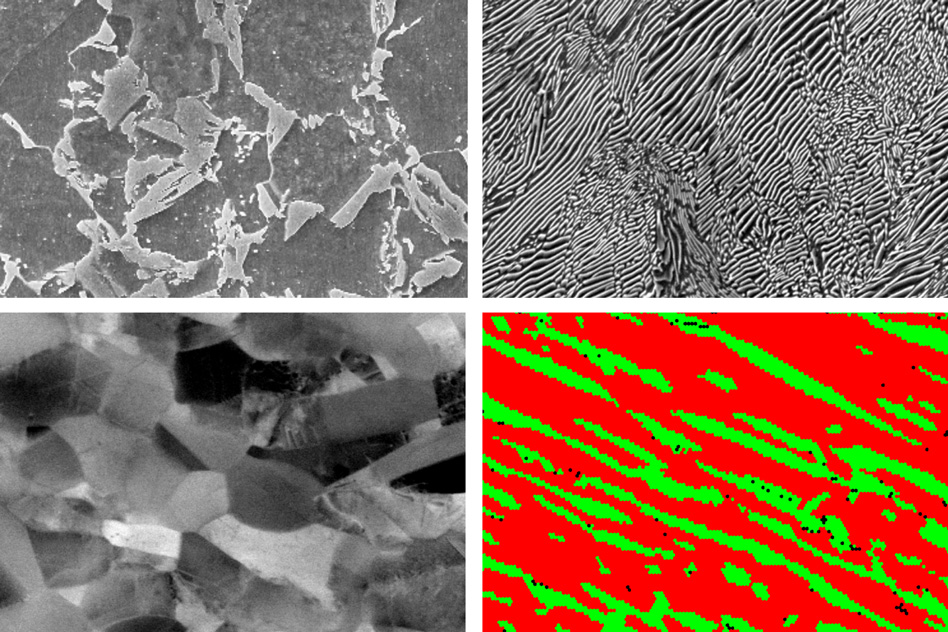Resisting microcracks from metal fatigue
March 14, 2017

Researchers have developed a type of steel with three characteristics that help it resist microcracks that lead to fatigue failure: a layered nanostructure, a mixture of microstructural phases with different degrees of hardness, and a metastable composition. They compared samples of metal with just one or two of these key attributes (top left, top right, and bottom left) and with all three (bottom right). The metal alloy with all three attributes outperformed all the others in crack resistance. (credit: Courtesy of the researchers)
A team of researchers at MIT and in Japan and Germany has found a way to greatly reduce the effects of metal fatigue by incorporating a laminated nanostructure into the steel. The layered structuring gives the steel a kind of bone-like resilience, allowing it to deform without allowing the spread of microcracks that can lead to fatigue failure.
Metal fatigue can lead to abrupt and sometimes catastrophic failures in parts that undergo repeated loading, or stress. It’s a major cause of failure in structural components of everything from aircraft and spacecraft to bridges and power plants. As a result, such structures are typically built with wide safety margins that add to costs.
The findings are described in a paper in the journal Science by C. Cem Tasan, the Thomas B. King Career Development Professor of Metallurgy at MIT; Meimei Wang, a postdoc in his group; and six others at Kyushu University in Japan and the Max Planck Institute in Germany.
“Loads on structural components tend to be cyclic,” Tasan says. For example, an airplane goes through repeated pressurization changes during every flight, and components of many devices repeatedly expand and contract due to heating and cooling cycles. While such effects typically are far below the kinds of loads that would cause metals to change shape permanently or fail immediately, they can cause the formation of microcracks, which over repeated cycles of stress spread a bit further and wider, ultimately creating enough of a weak area that the whole piece can fracture suddenly.
Nature-inspired
Tasan and his team were inspired by the way nature addresses the same kind of problem, making bones lightweight but very resistant to crack propagation. A major factor in bone’s fracture resistance is its hierarchical mechanical structure, with different patterns of voids and connections at many different length scales, and a lattice-like internal structure that combines strength with light weight.
So the team investigated microstructures that would mimic this in a metal alloy, developing a kind of steel that has three key characteristics, which combine to limit the spread of cracks that do form:
- A layered structure that tends to keep cracks from spreading beyond the layers where they start.
- Microstructural phases with different degrees of hardness, which complement each other, so when a crack starts to form, “every time it wants to propagate further, it needs to follow an energy-intensive path,” and the result is a great reduction in such spreading.
- A metastable composition — tiny areas within it are poised between different stable states, some more flexible than others, and their phase transitions can help absorb the energy of spreading cracks and even lead the cracks to close back up.
Next step, Tasan says, is to scale up the material to quantities that could be commercialized, and define which applications would benefit most.
The research was supported by the European Research Council and MIT’s Department of Materials Science and Engineering.
Abstract of Bone-like crack resistance in hierarchical metastable nanolaminate steels
Fatigue failures create enormous risks for all engineered structures, as well as for human lives, motivating large safety factors in design and, thus, inefficient use of resources. Inspired by the excellent fracture toughness of bone, we explored the fatigue resistance in metastability-assisted multiphase steels. We show here that when steel microstructures are hierarchical and laminated, similar to the substructure of bone, superior crack resistance can be realized. Our results reveal that tuning the interface structure, distribution, and phase stability to simultaneously activate multiple micromechanisms that resist crack propagation is key for the observed leap in mechanical response. The exceptional properties enabled by this strategy provide guidance for all fatigue-resistant alloy design efforts.